Filipino Nurses are at the Forefront of Global Healthcare
“Think of the number of Filipino nurses who lost their lives during the pandemic, because they were being pushed out to care for people with Covid early on,” said Dr. Peter Preziosi, President and CEO, Commission on Graduates of Foreign Nursing Schools International. CGFNS is the world’s largest educational assessment and credential evaluation organization for foreign nurses.
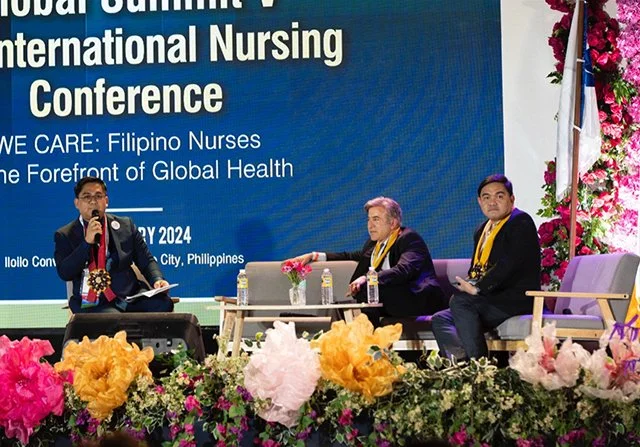
Dr. Peter Preziosi (center), President and CEO, Commission on Graduates of Foreign Nursing Schools International (CGFNS), told the conference participants that “Filipino nurses lost their lives during the pandemic, because they were being pushed out to care for people with Covid early on.”
Preziosi and many executives, directors and deans of American and Philippine healthcare organizations and nursing colleges were among the featured speakers at this year’s international conference and global summit on nursing held at Iloilo’s Convention Center on January 25-26. The global conference was co-sponsored by the Philippine Nurses Association (Philippines) (PNA), Philippine Nurses Association of America (PNAA), the Association of Deans of Philippine Colleges of Nursing, and the Commission on Filipinos Overseas.
In the United States, Filipino nurses comprise only 4 percent of the total nursing workforce, yet they paid a heavy price for their service: 26.4 percent of Covid frontline fatalities were Filipino nurses (2021 data). Earlier in the pandemic, the numbers for Filipinos were even higher at 31.5 percent fatality (2020 data).
Nurses of color paid a disproportionate price in the pandemic: 54.1 percent fatalities overall and 31.2 percent fatality for African American nurses, who comprise 12.4 percent of the total nursing workforce. Among nurses of color, Filipino fatalities comprise almost half of all lives lost (48.8 percent).
“Without Filipino nurses, the U.S. healthcare system would have been paralyzed,” Dr. Leo-Felix Jurado told TIME Magazine, as he noted the sacrifices made by Filipino nurses during the pandemic. At that time, Jurado was department chair of nursing at William Patterson University, and, like many nursing faculty and administrators, he saw the Philippines as a major source of nurses to fill their faculty staffing needs.
Jurado, now Dean of the College of Health Professions at the Commonwealth University in Pennsylvania, addressed key issues facing nursing education in America at the Iloilo conference.
“There’s so much demand for nurses in the workforce,” he noted in his speech. “But there is also a nurse faculty shortage.”
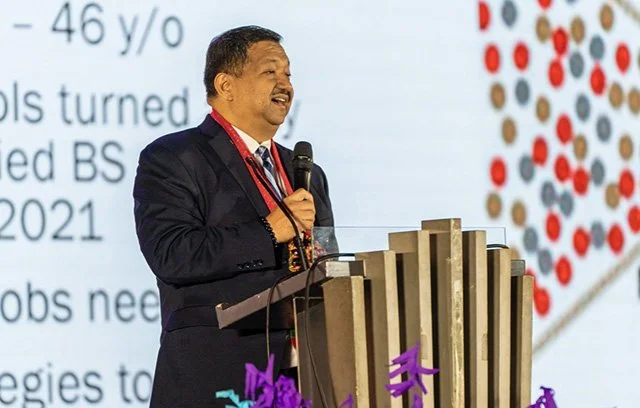
Dr. Leo-Felix Jurado was one of the featured speakers at the Iloilo international conference. He told TIME Magazine in a 2021 interview that “without Filipino nurses, the U.S. health care system would have been paralyzed during the pandemic.” Dr. Jurado is now Dean of the College of Health Professions, Commonwealth University and Executive Director, Philippine Nurses Association of America
In America, 2,200 faculty positions remain vacant nationwide, which leads to a large rejection rate for admission to nursing schools due to a lack of faculty: 91,938 applicants were rejected in 2021 even though they were academically qualified. Furthermore, the majority of nursing faculty with doctorates are now in their late 50s and approaching their retirement years, which will lead to further faculty shortages in the future.
One of the main solutions to the shortage is to recruit Filipino nurses to become clinical instructors in American universities. At one point, Jurado was recruiting so many Filipino nurses, who were also PNA members, that his college dean joked, “Are you bringing in the entire Philippine islands?”
Today, an estimated 160,000 Filipino nurses are working in the United States. In some major cities, especially those with large Asian populations, it seems half the nursing staff at hospitals are Filipino.
Path of a Filipino Immigrant Nurse
One Filipino nurse who immigrated to the United States is 51-year-old, Leonora Menguito, from Cebu, who currently works at the University of California San Diego Medical Center. She was attending the PNA conference for the first time.
“I graduated from Southwestern University in Cebu and migrated to Australia,” she explained in an interview at the conference. “I worked in Australia for eight years.”
In Australia, she met and married Steve, a Polish-Australian dual citizen who is a ship builder. They eventually made a second migration to California. “I really love Hollywood,” Menguito explained, “so I went to America.”
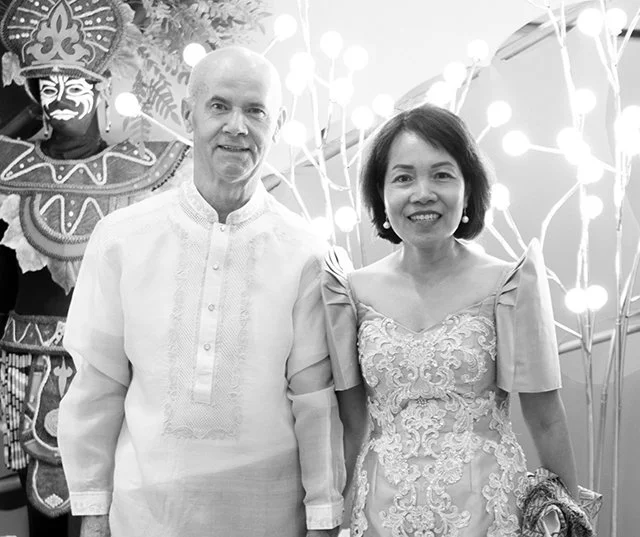
Leonora Menguito is a nurse from Cebu who immigrated first to Australia where she met and married her husband Steve, an immigrant from Poland. Menguito then made a second migration to the California where she works for the University of California San Diego Medical Center. This was her first Philippine Nurses Association conference, and she is shown here with Steve at the evening celebration at the conference.
Menguito has been working in California for 22 years and plans to retire in Cebu where she and Steve own an organic farm and plan to run a “farm to table” restaurant. As a nurse, she also funded the nursing education of her four nieces. Menguito sees her four nieces following her example by funding their relatives’ higher education, especially in nursing.
Menguito exemplifies Filipino nurses who have done well, successfully securing a high-paying nursing job in America at one of the nation’s top medical institutions. She has achieved the American Dream.
American Dream Began as a Nightmare
Sometimes, however, the path to becoming a nurse in America starts out as a nightmare.
“It’s not beds of roses,” Violeta Arnobit explained. Arnobit was born in Cebu and graduated from the Cebu Normal University’s College of Nursing.
In 1983, she was recruited to work as a nurse in New York City, but upon arrival in the Manila recruiter’s office, to her surprise, Arnobit was told she was not approved to immigrate to the United States. “As soon as I arrived in Manila, the recruiter said, ‘Who told you were leaving?’ … You’re not leaving yet. Your name is not on the list.”
Stunned, devastated, and suspicious that the recruitment firm was a scam, Arnobit went to the U.S. Embassy to check if her visa was approved. She found out that she was indeed approved for the work permit and immigration visa and that her immigration papers had been released to the Manila recruiter’s office. Arnobit and her mom went to church to pray for guidance.
The American recruiter in the U.S. confirmed she was approved for a work visa and travel to the United States and contacted the Manila office who told the Filipino recruiting staff to release Arnobit’s work permit and immigration visa. The Filipino woman staff scrambled to find Arnobit a flight to the U.S.
When she finally arrived in New York City in the spring of 1983, she was broke and freezing: “I only had $25 in my pocket. I will never forget that … it was very cold. It was early Spring.”
But that was just the beginning of her American nightmare.

Violeta Arnobit’s journey from Cebu to America started out as a nightmare, but through determination, resilience and perseverance and labor activism, she overcame human trafficking and job discrimination and exploitation in a New York City hospital. Today, Arnobit is a highly successful community leader, businesswoman and CEO of her own medical equipment company in Hawaii.
“As soon as we got there, the [hospital] administrator’s assistant collected all our passports. They said, ‘We have to keep this for safekeeping’,” Violeta continued. “We knew right then there that we were being taken advantaged of.”
When she arrived at the famous psychiatric general hospital in New York City, they were taken to their hospital “dorm.”
“I walked into a room with an old mattress on the floor. No beddings, nothing. It’s a very small room; it’s an abandoned building with no amenities. There were 60 nurses with non-functional bathrooms and showers, so we had to use a tabo (scoop) to shower. I never imagined that in the U.S. we had to use a tabo, mixing the hot and cold water.”
With only one place to bathe at their dorm, they had to take turns at the bathroom taking a tabo shower.
“We had no kitchen,” Violet added, “so we had rice cookers lining up in the hallway.” The company had expected them to eat in the hospital cafeteria and provided them with no kitchen.
Eventually, they all pitched in $50 and had enough money to hire an immigration rights lawyer. Their Jewish immigration lawyer told them, “No hospital or anyone should be holding your passport. That is illegal.”
“Without Filipino nurses, the U.S. healthcare system would have been paralyzed,” Dr. Leo-Felix Jurado told TIME Magazine.
Furthermore, after three months of working in the hospital, they never received a salary.
Violeta said that their living accommodations, work conditions and the fact that they “were not paid for three months was like slavery.”
Within a few months in New York, Arnobit studied and passed the nursing board exam and moved on to another hospital, St. Luke’s, which was part of the Mt. Sinai Hospital group. There she had adequate “subsidized housing and transportation.”
At St. Luke’s Hospital, she became a nursing recruiter herself, but Arnobit demanded that the hospital provide a fair contract for the Filipino nurses she recruited. Their nursing contracts stipulated that the hospital “paid for everything: their airfare to America and for adequate housing.”
Arnobit ended her story of determination, resilience and perseverance, and workers’ rights activism by saying, “If you don’t have a voice in America, people will just trample on you.”
Arnobit eventually got married and moved to Hawaii. With her work experience as a recruiter and negotiating business contracts with hospitals and universities, she started her own business and opened a very successful medical equipment company: ACE Medical Incorporated is a medical equipment company in Hawaii now on its 31st year. She is the CEO.
Arnobit is very active in her community and sits in prestigious boards, such as, Chaminade University’s Board of Trustees. She gives back to her community by going on medical missions. She’s currently enjoying life as an avid traveler, hiker, and trail runner. This summer, she hopes to hike the Camino de Santiago pilgrimage route in Spain and Portugal.
Economics of Filipino Nursing Migration
The economic impact of Filipino nursing migration and OFW migration (Overseas Filipino Workers) is huge. As the world’ largest exporter of nurses, the Philippines receives $38 billion in remittances from OFWs, which accounts for nearly 9 percent of the nation’s GDP, a significant amount of the nation’s economy.
Dr. Harby Abellanosa, CFO of Cebu South Medical Center, a teaching and training hospital, examined the economic challenges facing Filipino nurses and Philippine hospital staff shortages. He noted that even “BPOs [business process outsourcers] give better salaries (than our nurses get),” especially nurses who are working in hospitals.
The typical annual salary of a Filipino nurse in Manila is $4,900 a year (CGFNS International 2023 Report). In sharp contrast, a nurse in Philadelphia earns $72,000 a year, and, in major cities in California, nurses earn even higher salaries. BPO workers in mid-level careers can earn as high as $6,000 a year and seasoned BPO workers $9,600. Thus, the economic reasons for emigrating from the Philippines are quite compelling.
In return, the receiving countries also benefit financially by filling a nursing labor shortage in their hospitals and from the tax revenues generated by Filipino nurses.
However, the session on immigration ended in a slightly heated manner when Dr. Carmelita Divinagracia, a prominent professor, former dean, and leader in the nursing community, noted during the question-and-answer period that there remains an “acute nursing labor shortage” in the Philippines.
Divinagracia ardently stated, “We all know that, in the Philippines, with all due respect to the foreigners who are here today but who are Filipinos, that the recruitment going in the Philippines are all coming from the developed countries. The challenge is, how do we retain our nurses in the Philippines? I’m afraid that when I get sick, nobody is going to take care of me. They have all migrated because of the pay.”
Her statement was received with enthusiastic applause, especially at my table which was comprised mainly of nurse practitioners and educators, including two deans, from Pampanga. They expressed frustration and wanted the Philippine government to do more to raise nurses’ low salaries. They have no desire to emigrate and don’t want to be forced to do so because of low earnings.
AI and Cutting-Edge Medical Technology in Nursing
The other major issue that generated the largest interest at the conference was the issue of AI (artificial intelligence) and other advanced technologies in healthcare.
Some Filipino nurses are at the very forefront of using cutting-edge medical technology, especially AI and informatics, which is the systemic integration of advanced technology in the everyday diagnosis, data analysis, monitoring, and caring of patients.
“I’m very excited to be part of this digital revolution in healthcare,” said Dr. Romina Elias who is the Chief Nursing Informatics Officer (CNIO) at Dell Technologies, “and I think we are at the point and place where technology can be affordable and economical for a whole number of healthcare organizations.”
As a technology pioneer among Filipinos, Dr. Rozanno Locsin (Professor of Nursing at Tokushima University) is one of the most respected medical technology specialists and theorists in healthcare. Instead of his earlier view that robotics will be taking over half the work of nurses in hospitals, Dr. Locsin noted that what is currently happening in healthcare is that robotics and other medical technologies are becoming supplements to human nursing.
Today, the big issue in healthcare, he explained, is how can robots/robotics, machine learning and AI all contribute to “knowing” (diagnosing) the patient: “How can robots and robotics facilitate our knowing of persons? We use all this technology in order to practice nursing and to ‘know’ our patients who are the focus of our care. How do we use this technology?”
Locsin noted, “Technology is here to stay. It will never go away. Technology is anything that makes things more efficient. I’m not worried about machine-learning.”
Dr. Mary Joy Garcia-Dia, the Program Director of Nursing Informatics at New York-Presbyterian Hospital, who was moderating the panel shared the results of a live survey taken while the panel was going on: 80 percent of the nurses in the conference audience wanted to learn more about AI and other cutting-edge technologies in nursing.
Dr. Lourdes “Ludy” Marie Tejero raised an important issue about cutting-edge medical technologies: the lack of nurses participating in their invention. Tejero is the director of Technology Transfer and Business Development Office at UP Manila, where she oversaw and facilitated more than 100 medical innovations, inventions, and patents on medical technologies at UP Manila.
“My only frustration,” Dr. Tejero explained, “is that not one among those more than 100 inventions were from a nurse. Most of them were from doctors.”
Filipino Nurses as Role Models
The most important contributions of the Philippine Nurses Association (PNA) and the global conference on Filipino nurses is that young nursing students and practitioners were able to see many Filipinos in the field who have reached the very top of their respective careers.
One such rising star of the Philippine Nurses Association of America (PNAA) is Lourdes Moldre, the nurse executive and the patient care director of the University of California San Francisco Medical Mount Zion and Parnassus hospitals, one of the top medical centers in the United States.
A recipient of the Healthcare Hero award from the California State Senate and named by the San Francisco Business Times as one of the “40 Under 40” honorees, Moldre is very active with PNA and is the incoming president of the Norther Chapter of PNA of America (PNAA). She came from a family of nurses; both her parents are nurses. They immigrated to Napa, California in her teenage years.
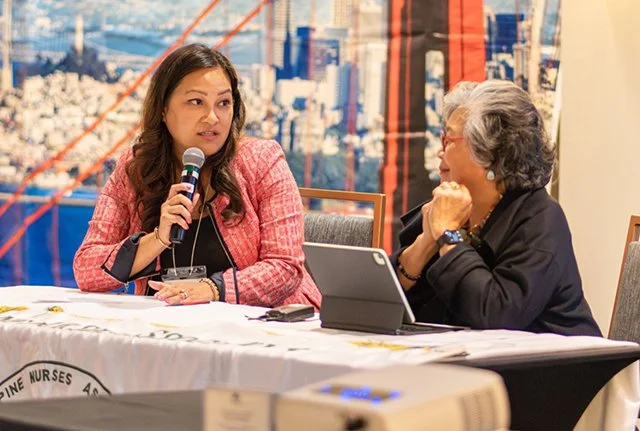
Lourdes Moldre (left), a nurse executive and the patient care director of the University of California San Francisco Medical Mount Zion and Parnassus hospitals, moderating a discussion at the October 2023 regional conference of PNAA Northern California. She is with Jennie Chin Hansen, one of the pioneers of elderly care in America who advocated for providing elderly care facilities for senior citizens. Moldre is a recipient of the Healthcare Hero award from the California State Senate and named by the San Francisco Business Times as one of the “40 Under 40” honorees.
“I oversee 10 acute care departments with 330+ acute care beds, 800+ clinical team members and 6 direct reports,” Moldre told me earlier when I asked her about her role as a hospital executive and administrator.
“These units include transplant, hematology-oncology, orthopedic and medical surgical. I provide leadership over day-to-day hospital operations along with service line expansions and staff retention.”
A Bright Future for Filipino Nurses
The new group and members of the Philippine Nurses Association, both in the Philippines and America, are young, talented, highly trained and educated, and exceptionally bright. They are at the very top of their respective fields, like Lourdes Moldre at UCSF Medical, Dr. Harby Abellanosa in Cebu South Medical Center, Dr. Romina Elias at Dell Technologies, Dr. Lourdes Tejero at UP-Manila, Dr. Marlon Garzo Saria at Providence Saint John’s Health Center, and many others both in America and the Philippines.
Filipino nurses provide t important daily nursing care and staffing for hospitals and universities in the Philippines, U.S., and globally. They are now are also at the very forefront of nursing leadership.
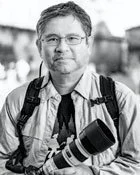
James Sobredo, Ph.D., is professor emeritus of Ethnic Studies at Sacramento State University. He is a journalist and documentary photographer who lives in Stockton and Sausalito.
More articles from James Sobredo






No comments:
Post a Comment